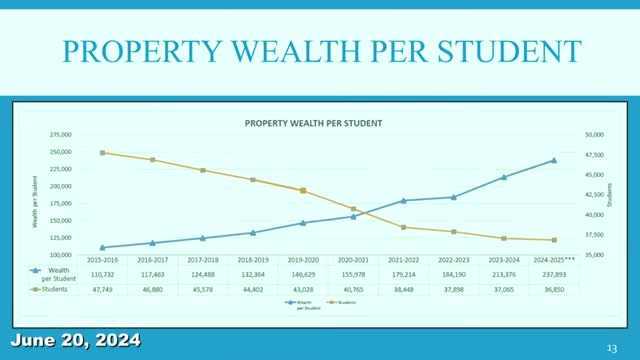Budget Crisis Looms as District Faces Deficit Challenges
June 21, 2024 | BROWNSVILLE ISD, School Districts, Texas

This article was created by AI summarizing key points discussed. AI makes mistakes, so for full details and context, please refer to the video of the full meeting. Please report any errors so we can fix them. Report an error »

During a recent government meeting, officials discussed critical financial matters affecting the district's budget and state aid. The presentation highlighted a significant increase in wealth per student, attributed to rising property values and declining student enrollment. This trend raises concerns about potential reductions in state aid, as the state may perceive the district as financially capable of operating independently due to its local revenue.
The district's unassigned fund balance was a focal point, with a projected need to draw approximately $23.6 million to balance the budget. This would reduce the fund balance from $116 million to $92.4 million, which, while compliant with state regulations, raises alarms about long-term sustainability. Officials emphasized the importance of monitoring this balance closely, as continued reliance on the fund could lead to financial instability.
Concerns were also raised about the impact of budget cuts on staff workloads, with some members questioning whether adjustments could be made on the vendor side rather than solely on employee budgets. The discussion underscored the need for a comprehensive review of staffing and resource allocation, particularly in light of the district's current capacity utilization.
Additionally, the meeting addressed upcoming changes in compensation due to new IRS guidelines, which will require adjustments to pay structures for exempt staff starting in January 2025. A proposed 2% general pay increase was discussed, with the understanding that the actual increase would vary based on individual pay grades.
Overall, the meeting highlighted the district's financial challenges and the need for strategic planning to ensure compliance with regulations while maintaining operational effectiveness. The discussions underscored the importance of proactive measures to address potential deficits and the sustainability of the district's financial health moving forward.
The district's unassigned fund balance was a focal point, with a projected need to draw approximately $23.6 million to balance the budget. This would reduce the fund balance from $116 million to $92.4 million, which, while compliant with state regulations, raises alarms about long-term sustainability. Officials emphasized the importance of monitoring this balance closely, as continued reliance on the fund could lead to financial instability.
Concerns were also raised about the impact of budget cuts on staff workloads, with some members questioning whether adjustments could be made on the vendor side rather than solely on employee budgets. The discussion underscored the need for a comprehensive review of staffing and resource allocation, particularly in light of the district's current capacity utilization.
Additionally, the meeting addressed upcoming changes in compensation due to new IRS guidelines, which will require adjustments to pay structures for exempt staff starting in January 2025. A proposed 2% general pay increase was discussed, with the understanding that the actual increase would vary based on individual pay grades.
Overall, the meeting highlighted the district's financial challenges and the need for strategic planning to ensure compliance with regulations while maintaining operational effectiveness. The discussions underscored the importance of proactive measures to address potential deficits and the sustainability of the district's financial health moving forward.
View full meeting
This article is based on a recent meeting—watch the full video and explore the complete transcript for deeper insights into the discussion.
View full meeting
